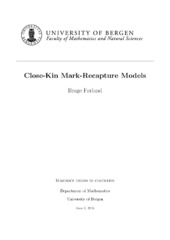Close-Kin Mark-Recapture Models
Master thesis
Permanent lenke
https://hdl.handle.net/1956/20644Utgivelsesdato
2019-07-09Metadata
Vis full innførselSamlinger
Sammendrag
Close-Kin Mark-Recapture (CKMR) is a recent extension of the ordinary mark–recapture methods used to estimate animal abundance and other population parameters. Where ordinary mark–recapture only consider the subsequent identification of the same animal a recapture, CKMR expands this by also viewing the genetic identification of a relatives as a recapture. One of the challenges of CKMR models compared to ordinary mark–recapture is that the recapture probabilities are tightly coupled to the life histories of the animals in questions. This thesis contains three different contributions to the CKMR literature. Firstly I develop a CKMR estimator for age structured populations, presented in Ruzzante (2019). Secondly, I develop theoretical background for half sibling CKMR analysis, and apply kin analysis to data from the River Etne. Thirdly, it expands on the results from Skaug (2017) and derives several new results for the case where age of both parent and offspring is unknown. The first part contains the method development of a parent–offspring CKMR model for brook trout populations, electrofished yearly in the period 2013-2018. I here develop a moment estimator for population size for an age structured model, related to the Lincoln–Petersen estimator. The estimator is applied under two different population assumptions, stable age structure, and variable recruitment and representative sampling. Special focus is on the small population situation, where large sample approximations used in previous CKMR studies cannot be assumed. A small sample bias correction for the estimator is developed and validated using parametric bootstrap simulations. Using the perspective that the parent marks the offspring instead of the commonly used offspring marks juvenile, a simple and general form of the estimator is derived. Viewing offspring as the marked part of the population also leads to an expression for the variance of the expected number of parent–offspring pairs in a sample, which is found to be less than the Poisson variance unless fecundity is very overdispersed. The second part contains theoretical background and model development for half sibling CKMR analysis, to examine the conditions under which same cohort siblings are suitable for CKMR analysis. A half sibling kinship analysis of single year data set of Atlantic salmon from the River Etne 2013 is performed to check if it is suitable for CKMR. In the third part, the probability that an individual has a living parent in an age structured population is discussed in detail. For the case where age information for both parent and offspring is unavailable, I derive two useful expressions for the probability of a living parent when mortality is constant, or constant after onset of maturity. With the additional assumption of constant population size, this probability is shown to be 1/2, similar to what is previously proved for constant fecundity.
